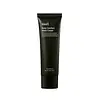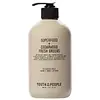What's inside
What's inside
 Key Ingredients
Key Ingredients

 Benefits
Benefits

 Concerns
Concerns

 Ingredients Side-by-side
Ingredients Side-by-side

Water
Skin ConditioningGlycerin
HumectantCaprylic/Capric Triglyceride
MaskingHelianthus Annuus Seed Oil
EmollientUndecane
EmollientPolyglyceryl-3 Distearate
Emulsifying1,2-Hexanediol
Skin ConditioningTridecane
PerfumingStearyl Alcohol
EmollientButyrospermum Parkii Butter
Skin ConditioningHydrogenated Lecithin
EmulsifyingGlyceryl Stearate Citrate
EmollientTrehalose
HumectantBetula Platyphylla Japonica Bark Extract
Skin ConditioningOrbignya Oleifera Seed Oil
EmollientPanthenol
Skin ConditioningPantolactone
HumectantPentylene Glycol
Skin ConditioningButylene Glycol
HumectantTocopherol
AntioxidantAlanine
MaskingArginine
MaskingCysteine
AntioxidantGlycine
BufferingHistidine
HumectantIsoleucine
Skin ConditioningLeucine
Skin ConditioningLysine
Skin ConditioningMethionine
Skin ConditioningPhenylalanine
MaskingProline
Skin ConditioningSerine
MaskingThreonine
Tyrosine
MaskingValine
MaskingAspartic Acid
MaskingGlutamic Acid
HumectantHyaluronic Acid
HumectantHydrolyzed Hyaluronic Acid
HumectantHydrolyzed Sodium Hyaluronate
Skin ConditioningHydroxypropyltrimonium Hyaluronate
Potassium Hyaluronate
Skin ConditioningSodium Hyaluronate
HumectantSodium Hyaluronate Crosspolymer
HumectantSodium Acetylated Hyaluronate
HumectantArachidyl Alcohol
EmollientBehenyl Alcohol
EmollientCetyl Alcohol
EmollientAcrylates/C10-30 Alkyl Acrylate Crosspolymer
Emulsion StabilisingTetrasodium EDTA
Tetrasodium Iminodisuccinate
Tromethamine
BufferingCarbomer
Emulsion StabilisingBehenic Acid
CleansingMyristic Acid
CleansingStearic Acid
CleansingEthylhexylglycerin
Skin ConditioningWater, Glycerin, Caprylic/Capric Triglyceride, Helianthus Annuus Seed Oil, Undecane, Polyglyceryl-3 Distearate, 1,2-Hexanediol, Tridecane, Stearyl Alcohol, Butyrospermum Parkii Butter, Hydrogenated Lecithin, Glyceryl Stearate Citrate, Trehalose, Betula Platyphylla Japonica Bark Extract, Orbignya Oleifera Seed Oil, Panthenol, Pantolactone, Pentylene Glycol, Butylene Glycol, Tocopherol, Alanine, Arginine, Cysteine, Glycine, Histidine, Isoleucine, Leucine, Lysine, Methionine, Phenylalanine, Proline, Serine, Threonine, Tyrosine, Valine, Aspartic Acid, Glutamic Acid, Hyaluronic Acid, Hydrolyzed Hyaluronic Acid, Hydrolyzed Sodium Hyaluronate, Hydroxypropyltrimonium Hyaluronate, Potassium Hyaluronate, Sodium Hyaluronate, Sodium Hyaluronate Crosspolymer, Sodium Acetylated Hyaluronate, Arachidyl Alcohol, Behenyl Alcohol, Cetyl Alcohol, Acrylates/C10-30 Alkyl Acrylate Crosspolymer, Tetrasodium EDTA, Tetrasodium Iminodisuccinate, Tromethamine, Carbomer, Behenic Acid, Myristic Acid, Stearic Acid, Ethylhexylglycerin
Water
Skin ConditioningCaprylic/Capric Triglyceride
MaskingGlycerin
HumectantCetyl Alcohol
EmollientButyrospermum Parkii Butter
Skin ConditioningCarthamus Tinctorius Seed Oil
MaskingBrassica Oleracea Acephala Leaf Extract
HumectantCamellia Sinensis Leaf Extract
AntimicrobialChamomilla Recutita Flower Extract
MaskingChlorella Vulgaris Extract
Skin ConditioningHydrolyzed Algin
Maris Aqua
HumectantMedicago Sativa Extract
TonicSpinacia Oleracea
Skin ConditioningAlanine
MaskingArginine
MaskingBetaine
HumectantGlutamic Acid
HumectantGlycine
BufferingLactobacillus Ferment
Skin ConditioningLysine Hcl
Skin ConditioningPCA
HumectantProline
Skin ConditioningSerine
MaskingSodium Hyaluronate
HumectantSodium Hydroxide
BufferingSodium Lactate
BufferingSodium PCA
HumectantTetrahexyldecyl Ascorbate
AntioxidantTetrasodium Glutamate Diacetate
Threonine
Tocopherol
AntioxidantCetearyl Olivate
Helianthus Annuus Seed Oil
EmollientMangifera Indica Seed
AbrasiveButter
Skin ConditioningSimmondsia Chinensis Seed Oil
EmollientSorbitan Olivate
EmulsifyingSqualane
EmollientCarbomer
Emulsion StabilisingMaltodextrin
AbsorbentCitral
PerfumingCitronellol
PerfumingHexyl Cinnamal
PerfumingLimonene
PerfumingLinalool
PerfumingEthylhexylglycerin
Skin ConditioningPhenoxyethanol
PreservativeSodium Benzoate
MaskingParfum
MaskingWater, Caprylic/Capric Triglyceride, Glycerin, Cetyl Alcohol, Butyrospermum Parkii Butter, Carthamus Tinctorius Seed Oil, Brassica Oleracea Acephala Leaf Extract, Camellia Sinensis Leaf Extract, Chamomilla Recutita Flower Extract, Chlorella Vulgaris Extract, Hydrolyzed Algin, Maris Aqua, Medicago Sativa Extract, Spinacia Oleracea, Alanine, Arginine, Betaine, Glutamic Acid, Glycine, Lactobacillus Ferment, Lysine Hcl, PCA, Proline, Serine, Sodium Hyaluronate, Sodium Hydroxide, Sodium Lactate, Sodium PCA, Tetrahexyldecyl Ascorbate, Tetrasodium Glutamate Diacetate, Threonine, Tocopherol, Cetearyl Olivate, Helianthus Annuus Seed Oil, Mangifera Indica Seed, Butter, Simmondsia Chinensis Seed Oil, Sorbitan Olivate, Squalane, Carbomer, Maltodextrin, Citral, Citronellol, Hexyl Cinnamal, Limonene, Linalool, Ethylhexylglycerin, Phenoxyethanol, Sodium Benzoate, Parfum
 Reviews
Reviews

Ingredients Explained
These ingredients are found in both products.
Ingredients higher up in an ingredient list are typically present in a larger amount.
Alanine is an amino acid and is already found in the human body. Our skin uses alanine to build collagen, elastin, and keratin.
Arginine is an amino acid that is important for human development. Your body uses is it to produce hair keratin and skin collagen.
As a cosmetic ingredient, Arginine has antioxidant properties and can also help repair damaged skin. This ingredient is derived either synthetically or from animals.
Arginine isn't fungal acne safe when used in the presence of other lipids (fats, fatty acids, oils, esters, etc). Oils and fats occur naturally within the skin, so take caution when using Arginine if you're prone to fungal acne.
Learn more about ArginineThis ingredient is also known as shea butter. It is an effective skin hydrator and emollient.
Emollients help soothe and soften your skin. It does this by creating a protective film on your skin. This barrier helps trap moisture and keeps your skin hydrated. Emollients may be effective at treating dry or itchy skin.
Shea butter is rich in antioxidants. Antioxidants help fight free-radicals, or molecules that may harm the body. It is also full of fatty acids including stearic acid and linoleic acid. These acids help replenish the skin and keep skin moisturized.
While Shea Butter has an SPF rating of about 3-4, it is not a sunscreen replacement.
Shea butter may not be fungal acne safe. We recommend speaking with a professional if you have any concerns.
Learn more about Butyrospermum Parkii ButterThis ingredient is an emollient, solvent, and texture enhancer. It is considered a skin-softener by helping the skin prevent moisture loss.
It helps thicken a product's formula and makes it easier to spread by dissolving clumping compounds.
Caprylic Triglyceride is made by combining glycerin with coconut oil, forming a clear liquid.
While there is an assumption Caprylic Triglyceride can clog pores due to it being derived from coconut oil, there is no research supporting this.
Learn more about Caprylic/Capric TriglycerideCarbomer is a polymer of acrylic acid. Its main role is to create a gel consistency.
A high amount of carbomer can cause pilling or balling up of products. Don't worry, most products contain 1% or less of carbomer.
Cetyl Alcohol is a fatty alcohol. Fatty Alcohols are most often used as an emollient or to thicken a product.
Its main roles are:
Though it has "alcohol" in the name, it is not related to denatured alcohol or ethyl alcohol.
The FDA allows products labeled "alcohol-free" to have fatty alcohols.
Learn more about Cetyl AlcoholEthylhexylglycerin (we can't pronounce this either) is commonly used as a preservative and skin softener. It is derived from glyceryl.
You might see Ethylhexylglycerin often paired with other preservatives such as phenoxyethanol. Ethylhexylglycerin has been found to increase the effectiveness of these other preservatives.
Glutamic Acid is an amino acid that is found in all living organisms. Our bodies use this to help nerve cells in the brain communicate with other cells.
In cosmetics, glutamic acid is a famous humectant. It draws water from the air to your skin, keeping your skin hydrated (like hyaluronic acid).
An in-vitro study from 2024 found glutamic acid to play a role in inhibiting inflammation and thus a potential skin-soothing ingredient.
Other studies show it to be have potential wound healing, skin barrier repair, and hair growth properties.
Glutamic acid has poor solubility in water and other solvents.
Learn more about Glutamic AcidGlycerin is already naturally found in your skin. It helps moisturize and protect your skin.
A study from 2016 found glycerin to be more effective as a humectant than AHAs and hyaluronic acid.
As a humectant, it helps the skin stay hydrated by pulling moisture to your skin. The low molecular weight of glycerin allows it to pull moisture into the deeper layers of your skin.
Hydrated skin improves your skin barrier; Your skin barrier helps protect against irritants and bacteria.
Glycerin has also been found to have antimicrobial and antiviral properties. Due to these properties, glycerin is often used in wound and burn treatments.
In cosmetics, glycerin is usually derived from plants such as soybean or palm. However, it can also be sourced from animals, such as tallow or animal fat.
This ingredient is organic, colorless, odorless, and non-toxic.
Glycerin is the name for this ingredient in American English. British English uses Glycerol/Glycerine.
Learn more about GlycerinThis ingredient is an amino acid that helps build proteins and moisturizes skin. It is already present in our skin as our bodies produce them naturally.
Glycine already plays a role in helping keep our skin moisturized as amino acids transport moisture throughout our skin.
As collagen is made up of glycine and other amino acids, it is believed glycine may help our skin produce more collagen.
Learn more about GlycineHelianthus Annuus Seed Oil is the oil derived from the seeds of a Sunflower. Sunflower seed oil is non-fragrant. It is an emollient, meaning it helps to soften the skin.
Sunflower seed oil contains many fatty acids. The fatty acids found in sunflower seeds include (from highest amount to least): linoleic acid, myristic acid, palmitic acid, stearic acid, arachidic acid, oleic acid, and linolenic acid.
These fatty acids help the skin create ceramides. Ceramides play a role in repairing the skin barrier.
Helianthus Annuus Seed Oil helps moisturize the skin. This in turn helps the skin look more rejuvenated and smoother.
Sunflowers are rich in vitamin E.
Historians believe Indigenous cultures of North America domesticated sunflowers before corn. Thus they relied on sunflower oil for a variety of uses. One such use is moisturizing skin and hair.
Sunflower seed oil may not be fungal acne safe. We recommend speaking with a professional if you have any concerns.
Learn more about Helianthus Annuus Seed OilProline is an amino-acid. It helps moisturize the skin and plays an important role in creating proteins.
Our skin uses proline as one of the building blocks for producing collagen.
In medicine, proline is used as an osmoprotectant. This means it helps prevent oxidative degradation in other drugs.
Our bodies are able to produce proline naturally, but certain conditions may inhibit this production. In that case, proline can be obtained from eating egg whites, soy protein, dairy products, asparagus, mushrooms, and seaweed.
Learn more about ProlineSerine is an amino acid naturally found in our body. Our bodies use amino acids to create protein.
Amino-acids help give keep our skin hydrated. They play an important role in the skin barrier, which keeps the skin plump and firm.
Serine is a non-essential amino acid, meaning we don't need to obtain it from eating foods.
Learn more about SerineSodium Hyaluronate is hyaluronic acid's salt form. It is commonly derived from the sodium salt of hyaluronic acid.
Like hyaluronic acid, it is great at holding water and acts as a humectant. This makes it a great skin hydrating ingredient.
Sodium Hyaluronate is naturally occurring in our bodies and is mostly found in eye fluid and joints.
These are some other common types of Hyaluronic Acid:
Learn more about Sodium HyaluronateThreonine is an amino-acid. It helps hydrate the skin and has antioxidant benefits.
Our skin uses threonine for creating collagen and elastin. Humans are not able to create threonine and must get it through eating foods such as fish, lentils, poultry, sesame seeds, and more.
Tocopherol (also known as Vitamin E) is a common antioxidant used to help protect the skin from free-radicals and strengthen the skin barrier. It's also fat soluble - this means our skin is great at absorbing it.
Vitamin E also helps keep your natural skin lipids healthy. Your lipid skin barrier naturally consists of lipids, ceramides, and fatty acids. Vitamin E offers extra protection for your skin’s lipid barrier, keeping your skin healthy and nourished.
Another benefit is a bit of UV protection. Vitamin E helps reduce the damage caused by UVB rays. (It should not replace your sunscreen). Combining it with Vitamin C can decrease sunburned cells and hyperpigmentation after UV exposure.
You might have noticed Vitamin E + C often paired together. This is because it is great at stabilizing Vitamin C. Using the two together helps increase the effectiveness of both ingredients.
There are often claims that Vitamin E can reduce/prevent scarring, but these claims haven't been confirmed by scientific research.
Learn more about TocopherolWater. It's the most common cosmetic ingredient of all. You'll usually see it at the top of ingredient lists, meaning that it makes up the largest part of the product.
So why is it so popular? Water most often acts as a solvent - this means that it helps dissolve other ingredients into the formulation.
You'll also recognize water as that liquid we all need to stay alive. If you see this, drink a glass of water. Stay hydrated!
Learn more about Water